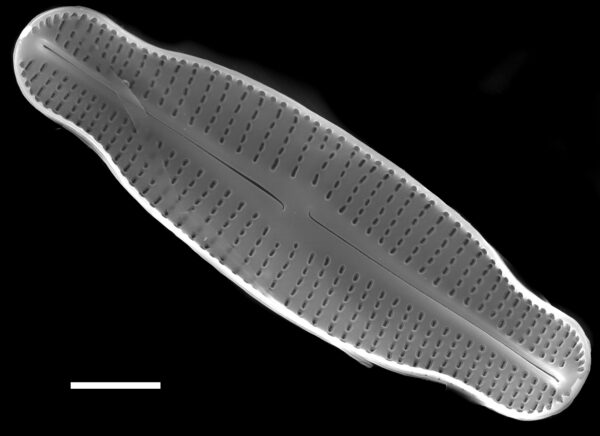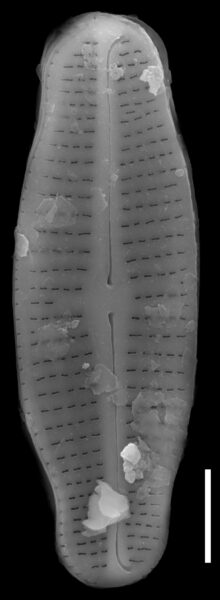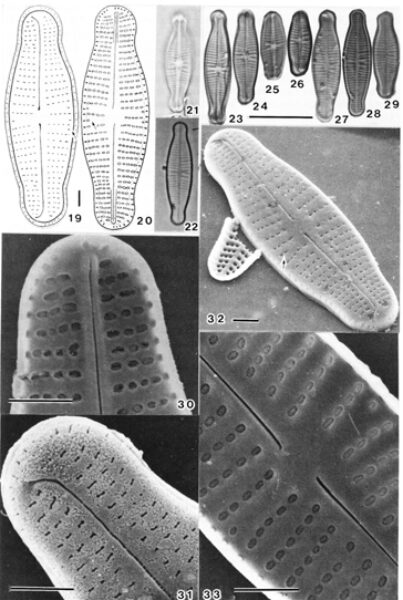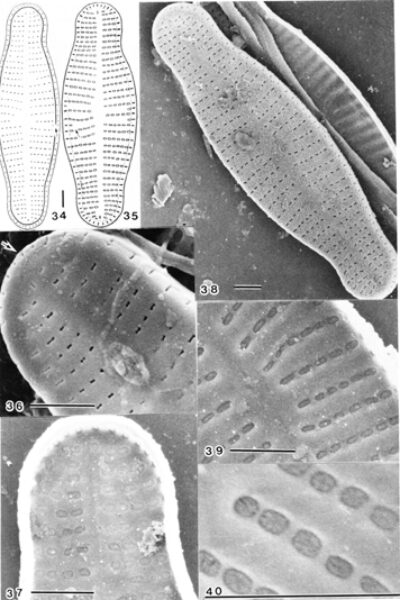Achnanthidium latecephalum
-
Category
-
Length Range10-16 µm
-
Width Range3.5-3.9 µm
-
Striae in 10 µm20-26 in the center valve, 35-40 at the ends
-
ContributorMarina Potapova - Aug 2010
-
ReviewerSarah Spaulding - Aug 2013
Identification
Description
Valves are linear-lanceolate with broadly rostrate or subcapitate ends. The raphe valve is concave and the rapheless valve is convex.Both valves possess a linear axial area, which widens slightly in the middle portion of the valve. No central area is present on either valve. The striae are parallel or very slightly radiate throughout both valves. Striae density on both valves is 20-26 in 10 µm in the middle and 35-40 in 10 µm at the apices. The external openings of the areolae are transapically elongated, appearing as narrow slits. Each stria in the middle part of the valve is composed of 4-5 areolae. Short marginal striae are often present in the middle portion of both valves. The raphe is straight, filiform. The terminal raphe fissures are hooked towards the same side of the valve and are slightly expanded at the ends. Externally, the central raphe ends are teardrop-shaped. Internally, the central raphe ends curve to opposite sides.
Autecology
-
Size Range, µm3
-
Motility
-
Attachment
-
Habitat
-
Colony
-
Waterbody
-
Distribution
- Learn more about this
Original Description
Valves linear-lanceolate with broadly capitate or rostrate ends, 10-18 μm long, 4.0-4.5 μm wide. Raphid valve: raphe straight and thread-like with slightly dilated central raphe endings somewhat distant from each other, and gently curved terminal fissures; axial area narrowly lanceolate, transapical striae slightly radiate, alternatively long and short in the middle, 18-20 in 10 μm, almost parallel near the ends, ca 34 in 10 μm; puncta forming striae invisible. Araphid valve: axial area linear lanceolate, transapical striae slightly radiate and occasionally having a short stria inserted in the middle, ca 22 in 10 μm, almost parallel near the ends, ca 34 in 10 μm; puncta forming the striae are invisible.
-
AuthorH.Kobayasi 1997
-
Length Range10-18 µm
-
Width4.0-4.5 µm
-
Striae in 10µm18-20 in center raphe valve, ca 22 in center rapheless valve, ca 34 at the ends
Citations & Links
Citations
-
Publication Link: 10.1016/j.limno.2007.01.004
Links
-
Index Nominum Algarum
-
North American Diatom Ecological DatabaseNADED ID: 1032
Cite This Page
Potapova, M. (2010). Achnanthidium latecephalum. In Diatoms of North America. Retrieved July 26, 2024, from https://diatoms.org/species/achnanthidium_latecephalum
Responses
The 15 response plots show an environmental variable (x axis) against the relative abundance (y axis) of Achnanthidium latecephalum from all the stream reaches where it was present. Note that the relative abundance scale is the same on each plot. Explanation of each environmental variable and units are as follows:
ELEVATION = stream reach elevation (meters)
STRAHLER = distribution plot of the Strahler Stream Order
SLOPE = stream reach gradient (degrees)
W1_HALL = an index that is a measure of streamside (riparian) human activity that ranges from 0 - 10, with a value of 0 indicating of minimal disturbance to a value of 10 indicating severe disturbance.
PHSTVL = pH measured in a sealed syringe sample (pH units)
log_COND = log concentration of specific conductivity (µS/cm)
log_PTL = log concentration of total phosphorus (µg/L)
log_NO3 = log concentration of nitrate (µeq/L)
log_DOC = log concentration of dissolved organic carbon (mg/L)
log_SIO2 = log concentration of silicon (mg/L)
log_NA = log concentration of sodium (µeq/L)
log_HCO3 = log concentration of the bicarbonate ion (µeq/L)
EMBED = percent of the stream substrate that is embedded by sand and fine sediment
log_TURBIDITY = log of turbidity, a measure of cloudiness of water, in nephelometric turbidity units (NTU).
DISTOT = an index of total human disturbance in the watershed that ranges from 1 - 100, with a value of 0 indicating of minimal disturbance to a value of 100 indicating severe disturbance.

Achnanthidium latecephalum
- Valve ends broadly rostrate or subcapitate
- Central area absent on both valves
- Striae parallel or slightly radiate throughout both valves
Valves linear-lanceolate with broadly rostrate or subcapitate ends. The axial area is narrow and only slightly widened at the valve center. A central area is absent. The striae are parallel or slightly radiate throughout both valves, 20-26 in 10 μm in the center valve.
 Diatoms of North America
Diatoms of North America












